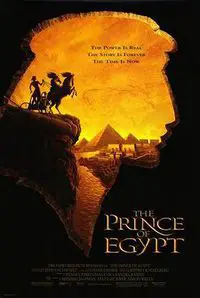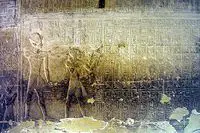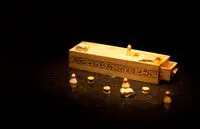Is the Film the Prince of Egypt Historically Accurate
When one considers the historical accuracy of the many films that depict the biblical Exodus, the 1998 animated film The Prince of Egypt is often overlooked. Unfortunately, perhaps because it is animated, many people tend to see the film, starring Val Kilmer as Moses and Ralph Fiennes as Ramesses II, as less serious and therefore less historically accurate, but that is a mistake. A review of The Prince of Egypt shows that just like all the other films about the Exodus, there are plenty of historical facts and some fictions. The film follows the biblical account of the Exodus fairly close, closer than some other films, and correctly portrays many details of New Kingdom Egypt, while adding its own healthy dose of fiction to make it an enjoyable family film.
Historical Fact in the Film
The film takes place primarily during the rule of the Egyptian King Ramesses II (ruled ca. 1279-1213 BC), who was the third king of the Nineteenth Dynasty during the New Kingdom. Today, based on the available primary sources and archaeological data, most biblical archaeologists and Egyptologists believe that the historical Exodus took place during the reign of Ramesses II. Exodus 1:11 mentions that the Hebrews aided in building the cities of Pithom and Rameses, which helps narrow the time and place down considerably. Although there were eleven kings named Ramesses, only one, Ramesses II, had a city named after him, so therefore the events must have taken place during his reign. [1] So the film accurately places the events in the proper period and further examination reveals that it also depicts many details from the period correctly.
Since the film was made for a family audience, there is less emphasis on warfare than there are in other films about the biblical Exodus. With that said, there are still a number of references to ancient Egyptian weapons and warfare made throughout The Prince of Egypt. The Egyptians are shown using sickle or “khephish” swords throughout the film, which is an accurate portrayal of the type of weapons that were used in the Late Bronze Age Near East. Archaeological evidence shows that the Egyptians imported the sickle sword from the Levant in the early New Kingdom (ca. 1500 BC) and pictorial evidence in the form of temple reliefs from Egypt shows that along with the bow, it was the primary weapon of the Egyptian army by the time of Ramesses II. The film also feature chariots heavily, which is also historically accurate. The chariot was the backbone of the Egyptian army of the period and was the elite corps of the military. The pharaohs would ride into battle on their chariots and fight alongside their troops. [2]
Another interesting detail, albeit not a very important one, the film gets correct is when Ramesses and later his son is shown wearing the so-called “side lock of youth.” The side lock of youth was a hairstyle in ancient Egypt that was designated primarily for male adolescents. The style was made by simply shaving the child’s head and leaving a braid on the side and was portrayed in numerous reliefs from different periods in ancient Egyptian history. Ramesses II is perhaps most famously shown wearing the hairstyle as he gives offerings with his father, Seti I (ruled ca. 1294-1279 BC), to the previous Egyptian kings in a relief from the Abydos Temple. The gods Horus and Khons were often depicted wearing side locks and since Horus was the god of kingship, it was probably connected to nobility in some way. [3] The side lock was exclusively shown being worn by children in art and further evidence of its connection to youth is found in the language. The Egyptian words for childhood, kherdew and nekhnew, used a determinative sign of a child with the side lock after each word. [4]
Another interesting detail that the film correctly depicts about life in ancient Egypt happens so quickly many would miss it. As Ramesses and Moses are chasing each other about the town, they go past two men playing a board game, which the Egyptians knew as senet. Although intact senet boards have been discovered along with playing pieces, unfortunately no directions were found with them so the rules of the game remain a mystery. It was probably the first board game played in world history and judging by the amount discovered, it was apparently quite popular. [5]
A final detail of pharaonic culture that the film correctly shows, to a certain degree, is when Ramesses is chasing the Hebrews from Egypt. It shows the Egyptian king wearing a round, blue crown, which modern scholars have termed the “war crown.” Due to pictorial reliefs showing different kings wearing the crown on the battlefield, it was believed for quite some time that it was worn in war, but now it is thought that it was ceremonial in nature. [6]
Of course it would not be a film about the Exodus if it did not show the biblical plagues. The plagues are related in detail in Exodus 7-11 and to many seem to be the most unrealistic part of the Exodus story. But recent studies by biblical archaeologists and Egyptologists have demonstrated that not only were the plagues possible, but probable to a certain extent. During the 1950s, biblical scholar Greta Hort examined the plagues critically and based on history, anthropology, geography, and biology, came to the conclusion that they were a historical reality. Hort’s work has recently been followed up by Kitchen, who presents a cogent argument for each plague. The Hort/Kitchen theory asserts that the blood was caused by oxygen fluctuations in the Nile River, which killed much of the fish, sending a horde frogs from the river. The dead and dying frogs brought forth a lice infestation and the excessive water from the seasonal flooding brought more insects that in turn infected the livestock with anthrax. Locusts arrived from the southeast, as they often did every few years. The darkness was the result of seasonal winds in March or April. The children would have been the most susceptible to the plague, but no one, including the Hebrews, could have escaped unharmed. All of it began in July or August during the annual inundation of the Nile River and ended about nine months later. [7]
One final point of ancient Egyptian history that The Prince of Egypt properly captured was the use of sand ramps to build monuments. The ramps are shown in numerous scenes in the film, such as when Ramesses and Moses ride their chariots up a large one. It is known that the Egyptians used ramps during the Old Kingdom (ca. 2575-2150 BC) to carry blocks as they built the pyramids. During the Old Kingdom, the Egyptians did not have the wheel so they improvised by pulling the limestone blocks on sleds up sand ramps. Once the project was finished the sand could either be removed or the desert winds would eventually blow it away. [8] The techniques the Egyptians used to build their monumental temples in the New Kingdom were essentially the same.
Historical Fiction in the Film
One of the primary points in the film that has a little fact and fiction in it is the very presence of the Hebrews in Egypt in the New Kingdom and their treatment. The film and the book of Exodus depict a large number of Hebrews slaving away to build temples for their cruel Egyptian overlords. It is known that large numbers of Canaanites and other foreign peoples began migrating to Egypt during the Middle Kingdom (ca. 1975-1640 BC) and that those numbers increased even more during the New Kingdom. Reliefs in the tomb of the New Kingdom noble Rekhmira show foreign workers, possibly slaves, making bricks, which does echo the story in the Exodus and the movie. [9] With that said, the Egyptians never practiced mass or chattel slave like it was practiced in the modern world. [10] So this depiction of the Hebrews being worked to death is partially true. There very well may have been Hebrew slaves in Egypt, possibly thousands, but they would not have been segregated and would have instead been working alongside slaves and workers from other lands, as well as native Egyptians.
One of the details in the film that was more anachronistic as opposed to being an outright fiction was the prominence of camels. Yes, camels were a major part of travel and sometimes warfare in the pre-modern Middle East, which included Egypt, but in the Late Bronze Age they were primarily used as pack animals and for food. It was not until after the Bronze Age when they were first ridden as they were in the film. [11]
Perhaps the biggest historical inaccuracy shown in the film is the relief in the temple that depicts Hebrew children being thrown into the Nile River. Although the Egyptians were known to do some brutal things in warfare just as other people in the region and period did, there is no evidence that they ever threw their enemies’ children into the Nile. In fact, there is no evidence that the Egyptians practiced infanticide either. The Egyptians only memorialized their battlefield victories and slaughtering the children of their vanquished enemy would certainly not be something they would have written about or depicted in art. [12]
Conclusion
The film The Prince of Egypt is an animated portrayal of the biblical Exodus story that is complete with some great animation, good music, and quality writing. It accurately depicts many elements of life in New Kingdom Egypt, but in the quest for dramatic effect it gets a couple of things noticeably wrong. Still, this is a quality film that anyone interested in the history of the Late Bronze Age or ancient Egypt is sure to enjoy.
References
- ↑ Kitchen, Kenneth A. On the Reliability of the Old Testament. (Grand Rapids, Michigan: William B. Eerdmans, 2003), p. 255
- ↑ Spalinger, Anthony. War in Ancient Egypt: The New Kingdom. Malden, Massachusetts: Blackwell, 2005), pgs. 17-23; 198-201
- ↑ Shaw, Ian, and Paul Nicholson. The Dictionary of Ancient Egypt. (London: Harry N. Abrams, 1995), p. 270
- ↑ Faulkner, Raymond O. A Concise Dictionary of Middle Egyptian. (Oxford: Griffith Institute, 1999), pgs. 138; 204
- ↑ Shaw and Nicholson, p. 107
- ↑ Shaw and Nicholson, p. 75
- ↑ Kitchen, p. 251
- ↑ Lehner, Mark. The Complete Pyramids. (London: Thames and Hudson, 2001), p. 215-17
- ↑ Kitchen, p. 247
- ↑ Shaw and Nicholson, p. 272
- ↑ Drews, Robert. The End of the Bronze Age: Changes in Warfare and the Catastrophe ca. 120 BC. (Princeton, New Jersey: Princeton University Press 1993), p. 165
- ↑ Kitchen, p. 246


